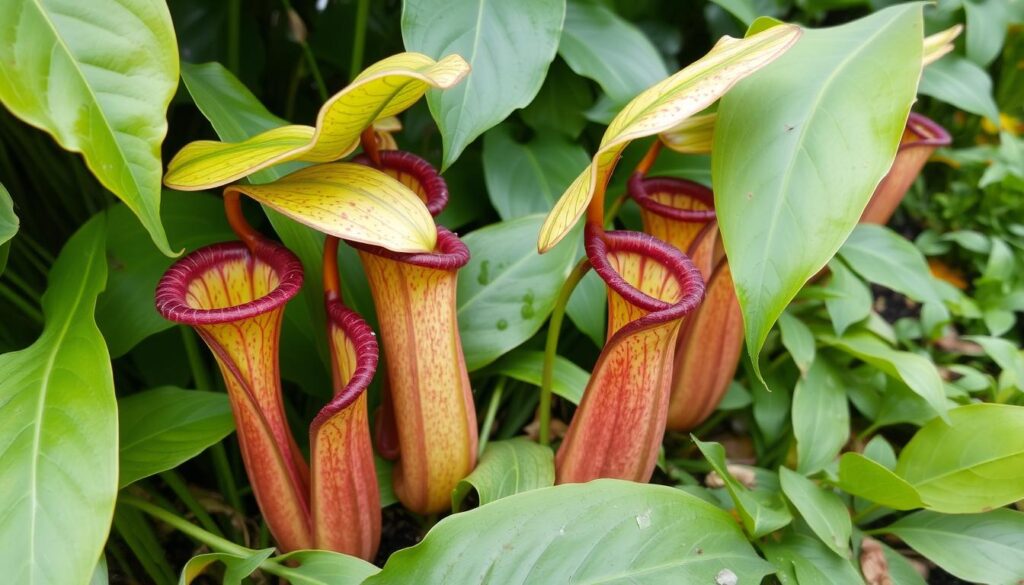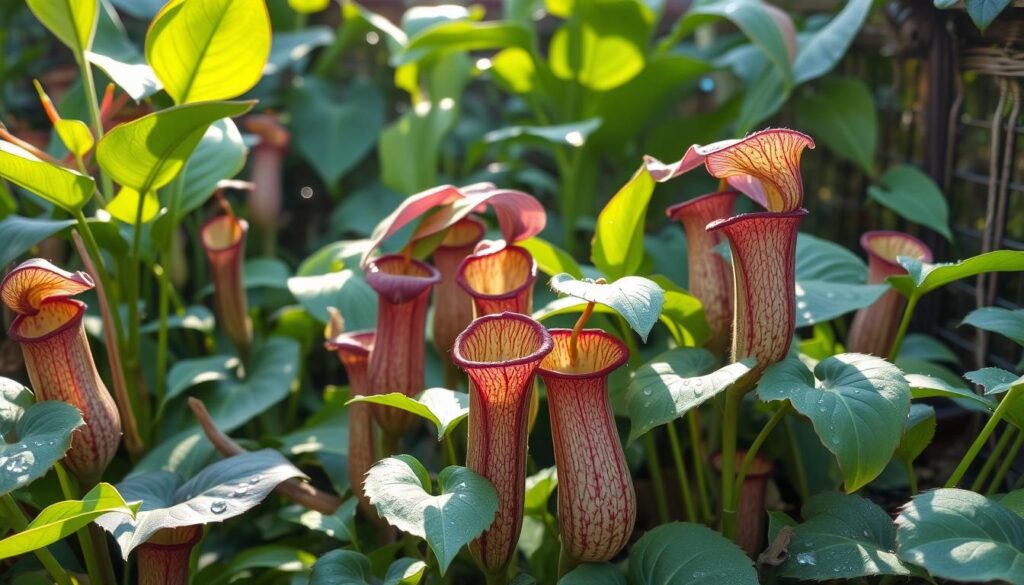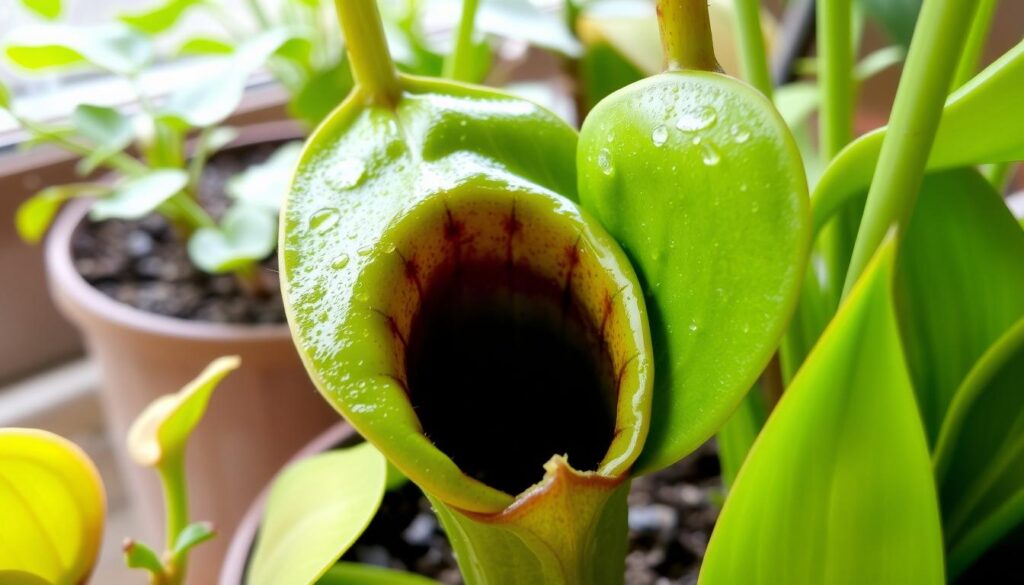Trimming pitcher plants is crucial for gardeners who want to keep them healthy and vibrant. Knowing how to prune them right can boost growth, prevent diseases, and improve their appearance. Using the proper pruning methods, you can make your pitcher plants stronger and your garden more lush.
This guide teaches you the basics of trimming pitcher plants. It’s designed to give you the confidence and skills to care for these plants effectively. You can make your garden a beautiful and thriving space with the proper knowledge.
Table of Contents
What Are Trimming Pitcher Plants?
Trimming pitcher plants serves to enhance their health and appearance. Understanding the characteristics that define these unique plants is essential for effective care. Pitcher plants belong to a specialized group of carnivorous plants capable of trapping and digesting insects to supplement nutrient intake. Their morphology features specialized structures known as pitchers, which retain digestive fluids. The most prominent genera include Nepenthes and Sarracenia.
Overview of Pitcher Plants
The fascination with pitcher plants lies in their distinct adaptations. Each plant’s pitcher is lined with slippery surfaces and often contains digestive enzymes that break down prey. In habitats where soils are nutrient-deficient, these adaptations allow them to thrive. Pitcher plants predominantly flourish in tropical and subtropical regions, with their growth greatly influenced by temperature and humidity levels. Ideal conditions typically involve:
- Temperature range: 70-90°F (21-32°C)
- Humidity levels: 50-70%
- Soil composition: peat-rich environments with a pH of approximately 3
Different Species of Pitcher Plants
Numerous species of pitcher plants exist within the Nepenthes and Sarracenia genera. Each species exhibits unique characteristics and care needs. For example, over 100 species of Nepenthes are recognized, commonly termed tropical pitcher plants. They thrive in a temperature span of 20°C to 35°C and require substantial humidity.
Sarracenia, or trumpet pitcher plants, exhibit tall, slender tubes and can adapt to various sunlight patterns. The species vary significantly in appearance and growth habits, impacting their care. Understanding the specific requirements of each species of pitcher plants can greatly assist in successful cultivation. In environments where humidity is consistently high and temperatures well-regulated, these captivating carnivorous plants can flourish and thrive.
Why Trimming Pitcher Plants is Essential
Trimming pitcher plants is not merely a cosmetic endeavor. This practice serves multiple vital functions that significantly contribute to the overall health and vitality of these unique plants. Understanding the core reasons behind the necessity of trimming can empower gardeners to maximize the benefits of trimming pitcher plants, leading to healthier plants, effective pest prevention, and improved aesthetics.
Promotes Healthy Growth
Pruning redirects a pitcher plant’s energy towards producing new and robust growth. Instead of sustaining dead or damaged foliage, a well-timed trim can encourage a healthy growth rate, potentially improving plant vitality by up to 30%. Regularly removing undesirable parts ensures that the plant allocates resources effectively, resulting in lush and vibrant foliage.
Prevents Disease and Pests
Another crucial advantage of trimming pitcher plants is pest prevention. By removing yellowed or decaying leaves, gardeners can drastically reduce the chances of disease taking hold and pest infestations becoming serious. A clean environment minimizes the risk of fungal and bacterial issues, ensuring the plant retains its natural defenses against common nuisances like mealybugs and spider mites.
Enhances Aesthetics
Well-maintained pitcher plants not only shine in health but also in appearance. Regular trimming pitcher plants enhances airflow and allows light to penetrate the foliage, resulting in a visually appealing arrangement. The aesthetics of a clean and tidy plant correspond directly to its health, making such trimming practices essential for any dedicated gardener.

| Benefit | Description |
|---|---|
| Promotes Healthy Growth | Redirection of energy towards new growth, improving vitality by up to 30%. |
| Pest Prevention | Reduction of dead and decaying foliage minimizes disease and pest risks. |
| Enhances Aesthetics | Better airflow and light penetration create a more visually appealing plant. |
Tools You Need for Trimming
Effectiveness of trimming pitcher plants relies heavily on the right tools. Choosing appropriate pruning equipment not only ensures a cleaner cut but also contributes to the overall health of the plants. For this task, understanding the importance of quality pruning tools and protective gear is essential. Below, find the recommended tools that will help in maintaining healthy, thriving pitcher plants.
Recommended Pruning Shears
Sharp, sterile pruning shears or scissors are vital for making clean cuts during the trimming process. Using high-quality pruning tools minimizes the risk of damaging stems or leaves, which can lead to disease. Some top choices include:
- Felco Classic Pruning Shears
- Corona Classic Bypass Pruner
- Fiskars Softgrip Bypass Pruner
When selecting trimming equipment, consider ergonomics and ease of use, especially for extended trimming sessions. Sterilizing cutting tools before use helps prevent the spread of pathogens.
Protective Gloves
Using protective gloves during trimming pitcher plants is highly advisable. Gardening gloves shield hands from sharp edges and potential irritants, particularly when working with species that possess tough or sharp foliage. Opt for gloves that provide a good grip while allowing dexterity. Recommended types include:
- Leather Gardening Gloves
- Latex-Coated Gloves
- Cotton Gloves with Rubber Grip
By equipping oneself with suitable pruning tools and protective gloves, gardeners can carry out trimming pitcher plant tasks effectively while ensuring their safety and the health of their plants.
When is the Best Time to Trim?
Understanding the timing of pruning is crucial for the health and appearance of pitcher plants. Identifying the best time to prune ensures that the plants can recover and thrive in their environment. Seasonal pruning is pivotal to enhancing growth and maintaining plant structure.
Seasonal Considerations
The best time to prune pitcher plants is late winter or early spring. This timing aligns with the onset of their active growth phase, allowing the plants to heal effectively as new growth begins. Ideally, pruning should occur before the growing season starts, helping the plants adapt to forthcoming conditions. It is advisable to manage the frequency of pruning adjustments; less frequent pruning is needed in winter due to shorter days and lower light levels, while more regular grooming is essential during the longer days of spring and summer.
Signs Your Plants Need Trimming
Recognizing the signs to trim is vital for pitcher plants. Look for the following indications:
- Yellowing or browning leaves
- Wilting or damaged foliage
- Overgrown appearance or increased density
These signs suggest that a trim is necessary to maintain plant health and aesthetics. Addressing these issues promptly will support the overall vitality of the plant. For additional guidance on maintaining proper care, visit this informative resource.

| Season | Pruning Recommendations | Signs to Trim |
|---|---|---|
| Winter | Minimal pruning | None typically observed |
| Early Spring | Ideal time for significant pruning | Yellowing and damaged leaves |
| Summer | Regular checks; trim as needed | Overgrowth and disarray |
| Fall | Prepare for dormancy; light trimming | Signs of stress or damage |
How to Trim Pitcher Plants Properly
Trimming pitcher plants involves specific techniques to ensure healthy growth and vitality. Understanding the proper trimming techniques can minimize stress on the plants and promote a robust appearance. Here’s a detailed guide to trimming your pitcher plants effectively.
Step-by-Step Guide
Follow these instructions for a successful trimming session:
- Clean your pruning tools thoroughly to avoid transmitting diseases.
- Identify any dead or damaged pitchers, focusing on areas where more than 50% of the surface is brown due to lack of moisture.
- Remove damaged pitchers by cutting them at the base with precision to prevent harming the main vine.
- Aim to cut no more than one-third of the plant’s total mass to minimize stress.
- After trimming, ensure the plants receive adequate sunlight and moisture to recover.
Common Mistakes to Avoid
Being aware of common pruning mistakes can enhance your trimming effectiveness:
- Do not over-trim, as excessive cutting can lead to plant stress and decline.
- Avoid trimming during the flowering or growing season, as this can disrupt the plant’s natural processes.
- Make sure your cuts are clean and sharp to prevent injury to the plant.
- Using unsterilized tools can introduce pests or diseases to your pitcher plants.
Applying these techniques will help maintain the health and aesthetics of your pitcher plants while preventing stress and disease. Understanding the nuances of trimming can lead to a thriving garden.
Maintenance After Trimming
After trimming pitcher plants, effective post-trimming care is vital for their recovery and growth. Proper attention to watering and fertilization ensures that these unique plants thrive in their environment.
Watering Guidelines
When caring for pitcher plants post-trimming, it is essential to maintain consistent moisture levels. Gentle watering is key, as watering pitcher plants should allow the soil to dry slightly between sessions. This approach helps keep the soil moist yet well-drained, reducing the risk of root rot.
Fertilization Tips
Although pitcher plants derive nutrients from captured insects, the necessity for additional fertilization may arise in low-insect environments. During the growing season, applying diluted fertilizer can provide benefits, but care must be taken to avoid over-fertilization as it may harm the plants. Wait for a few weeks post-trimming before introducing fertilizer to allow the plants time to recover from the stress of cutting.

Troubleshooting Common Issues
Pitfall plants can exhibit various problems that require attention from dedicated gardeners. Recognizing stress signs and understanding pest management strategies are essential for maintaining the health of pitcher plants. Below is a comprehensive overview of how to identify these issues and effectively address them.
Identifying Stress Signs
Gardeners should be on the lookout for specific stress signs that indicate potential pitcher plant issues. Common indicators include:
- Wilting: A loss of turgor pressure often points to insufficient water.
- Discoloration: Leaves turning yellow may signify underwatering, while dark or mushy spots could indicate a fungal issue resulting from excessive moisture.
- Rotted pitchers: This can arise from overwatering or poor drainage, leading to root rot and other complications.
Dealing with Pest Infestations
Pest management is crucial for protecting pitcher plants from common insect threats. The following pests frequently target these flora:
- Mealybugs: These pests can be identified by their white, cotton-like appearance and can cause significant damage if not controlled.
- Spider mites: Tiny and often hard to see, spider mites can create a stippled appearance on leaves and are notorious for causing stress to the plant.
To manage these insects, monitor plants closely and apply non-toxic insect sprays, such as neem oil, when pests are detected. Regular inspections and treatments can help safeguard plant health.
| Pest | Identification | Control Measures |
|---|---|---|
| Mealybugs | White, cottony clusters on leaves | Apply neem oil, manually remove with cotton swabs |
| Spider Mites | Tiny red or yellow specks, fine webbing | Increase humidity, use insecticidal soap or neem oil |
| Leafhoppers | Small green or brown insects, quick movement | Introduce natural predators or use insecticidal soap |
| Black Vine Weevil | C-shaped larvae, adult size 3/8 to 1/2 inch | Use insect traps, apply beneficial nematodes |
Understanding and addressing these stress signs and pest management techniques will empower gardeners to nurture their pitcher plants effectively. By being proactive, the longevity and vitality of these unique plants can be ensured.
Best Practices for Trimming Depending on the Species
Trimming pitcher plants requires an understanding of each species’ unique needs. This attention to detail ensures that the plants remain healthy and continue to thrive. By applying species-specific pruning techniques, enthusiasts can maintain the vigor and aesthetics of their pitcher plants, including Sarracenia, Nepenthes, and Cephalotus.
Sarracenia Care
Sarracenia plants, often known for their trumpet-shaped pitchers, benefit significantly from hands-on care. Focus on trimming during dormancy, which spans from fall to early spring. By removing damaged or yellowing pitchers, gardeners encourage robust growth as the warmer months approach. Sarracenia trimming emphasizes healthier new growth and enhances the plant’s overall appearance.
Nepenthes Care
Nepenthes species, or tropical pitcher plants, thrive in humid environments. For optimal Nepenthes care, pruning should occur after the appearance of new growth. This practice supports the shape of the plant while fostering more robust development of pitchers. It is essential to make clean cuts at the base of wilted leaves and old flowers to rejuvenate the plant while maintaining its aesthetic integrity.
Cephalotus Care
Cephalotus, known for its distinctive appearance, is another fascinating member of the pitcher plant family. Pruning should focus on removing only dead materials. Care must be taken to avoid disturbing the healthy leaves and rosettes, which are crucial for the plant’s growth and functionality. This gentle, species-specific approach ensures that the Cephalotus continues to thrive without disruption.
Understanding the Growth Cycle of Pitcher Plants
For dedicated gardeners, comprehending the growth cycle of pitcher plants is pivotal for effective care and management. These fascinating plants progress through distinct phases each year, encompassing both a dormant period and an active growth phase. Recognizing these stages not only enhances a gardener’s ability to nurture these unique species, but it also informs the timing of critical maintenance activities, such as trimming.
Growth Stages Overview
During the colder months, typically from November to February, pitcher plants enter a dormant phase, necessitating cooler temperatures and a reduction in water. In contrast, the warmer months signal their active growth phase, where they thrive and often require more attention. Understanding this growth cycle allows gardeners to tailor their care routines, ensuring that the plants are properly hydrated and positioned for optimal sunlight, which is essential for invigorating growth.
Timing Your Trims
The timing trimmings is crucial for promoting healthy foliage and encouraging new growth. It is generally advisable to prune before the onset of the active growth period, aligning cuts with environmental cues like increasing day length and rising temperatures. This strategy ensures that plants can rebound effectively after trimming, thus enhancing both their health and aesthetic appeal. Keeping a close eye on these seasonal changes helps ensure that pitcher plants are kept in peak condition throughout their growth cycle.
Frequently Asked Question
Should You Cut Back a Pitcher Plant?
Yes, trimming your pitcher plant is a good idea, but only when necessary. If you notice dead or dried-up pitchers, snip them off to keep the plant healthy and looking good. This allows the plant to redirect its energy to new growth instead of wasting it on old, non-functional pitchers. Think of it as giving the plant a quick tidy-up!
Should I Cut the Flower Off My Pitcher Plant?
It depends on your goals. If you’re not trying to harvest seeds, it’s a good idea to cut the flower off after it blooms. Flowers take up a lot of energy that could otherwise go toward producing more pitchers. So, if you want a thriving, bushy plant, trimming the flower is a smart move.
Why Are the Edges of My Pitcher Plant Turning Brown?
Browning edges are usually a sign of stress. Here’s what could be going on:
Humidity issues: Pitcher plants thrive in humid environments. If your air is too dry, the edges of the pitchers might crisp up.
Water quality: They prefer distilled or rainwater. Tap water with minerals or chemicals can cause browning.
Light: Too much direct sunlight or not enough light can lead to unhappy plants.
Age: Sometimes pitchers just age out and brown naturally. That’s normal!
Check your care routine, and adjust as needed.
Can You Take a Cutting From a Pitcher Plant?
Yes, you can! Pitcher plants can be propagated through cuttings, but it’s a bit of a slow process. Choose a healthy stem with a couple of leaves, then cut it just below a node (a swollen part where leaves attach). Stick the cutting in a mix of sphagnum moss and perlite, keep it humid, and be patient—it can take weeks to root.
How Do I Make My Pitcher Plant Happy?
Here’s the lowdown for a thriving plant:
Water: Use distilled or rainwater. Keep the soil damp but not waterlogged.
Light: Bright, indirect light is best. Some species can handle full sun, but be careful not to fry them.
Humidity: They need high humidity, so mist them often or keep them in a terrarium.
Feeding: If they’re indoors without access to insects, feed them once a month with diluted orchid fertilizer or drop in a small bug.
Patience: These plants grow slowly, so don’t stress if you don’t see rapid changes.
Where to Cut Off Dead Pitchers?
Cut dead pitchers at the base, as close to the stem as possible, without damaging the main plant. Use sharp scissors or pruning shears to make a clean cut. This will keep the plant neat and prevent energy from being wasted on dying parts.

